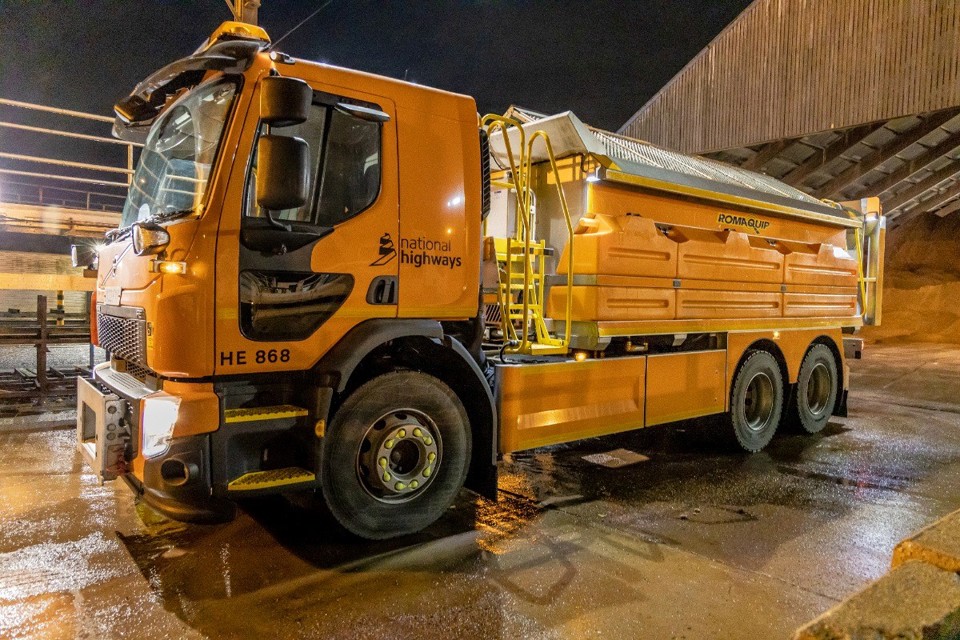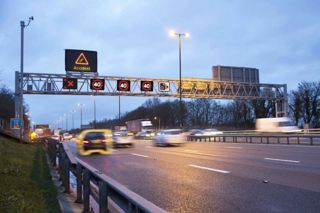National Highways has deployed the first of its 530-strong fleet of gritter vehicles this week, after the Met Office issued a series of severe weather warnings.
Gritters are going out this week for the first significant operation of this autumn and winter season on motorways and major A-roads as temperatures dip across the country.
With milder weather in October and November, minimal action was needed on England’s 4,500-mile strategic road network, with road surface temperatures staying above +1 degrees C – until now.
A number of Met Office National Severe Weather Warnings have been issued as an arctic maritime airmass brings cold weather to the UK with a risk of ice, wintry showers and snow.
In England there are yellow weather warnings for ice in North Cornwall and North Devon as well as along the East coast and northern England.
Further severe weather warnings could be issued as we head through the week.
Darren Clark, severe weather resilience manager at National Highways, said: “Not all roads will need treating on any given day.
“Gritters may need to go out in some regions if road temperatures fall below +1 degrees C, and if there is a risk of ice forming, but not in other areas if conditions are not as cold.”
National Highways says it is committed to treating every road which needs to be treated – whenever it is needed.
“We are armed with the latest technology, forecasting intelligence and years of experience to help us make informed decisions about where and when we need to spread salt to help keep road users safe in even the most adverse weather conditions,” added Clark.
National Highways recently completed a £44m two-year investment in a fleet of 252 Volvo gritter vehicles, some of which carried out winter operations last year, and all of which will be involved in salt spreading this season.
The investment now means the organisation has around 530 gritter vehicles available this winter, working from 128 depots. A total of 443 of these vehicles are Volvo gritters.
Vehicles in its winter gritting fleet are capable of carrying 12,000 kg of salt, or 8,400 kg of salt and 3,600 litres of brine at any one time.
The Volvo gritting vehicles can spread up to 50mph, encouraging traffic to keep moving more effectively on the roads even when they are being treated. When not treating they can travel up to 56mph.
However, National Highways is keen for motorists to continue to give gritter vehicles the time and space they need to do their jobs – to keep us all safe when we are travelling on its motorways and A-roads.
Clark said: “I was out with a salting team one year in Strensham. I witnessed some motorists driving carelessly to try to avoid our vehicle – but in turn putting them, their passengers, us and other road users at risk.
“As our gritting teams go out more and more to spread salt on the roads this coming autumn and winter season, our message is simple to all road users, please be patient and give us the time and space to do what we need to do to keep you safe.
“If you are going to pass us, please do so courteously, pass us safely and legally, or even better, if you are able to stay back, you will actually help the salt on the road activate even more quickly by crushing and breaking it into the road surface which benefits everyone.”
Along with more than 250 weather stations, that provide National Highways with real time information about localised road conditions, it also works with independent meteorological experts at DTN and Metdesk.
Abigail Oakes, senior account manager at the Met Office, said: “Our staff, be that meteorologists embedded alongside the National Highways team in Birmingham during the autumn and winter, or Met Office staff working from Exeter to deliver and support throughout the year, are proud to continue this partnership, which allows for the best possible support for road users during periods of severe weather.”
National Highways revealed it has a stockpile of around 280,000 tonnes of salt for the autumn and winter season.























Login to comment
Comments
No comments have been made yet.